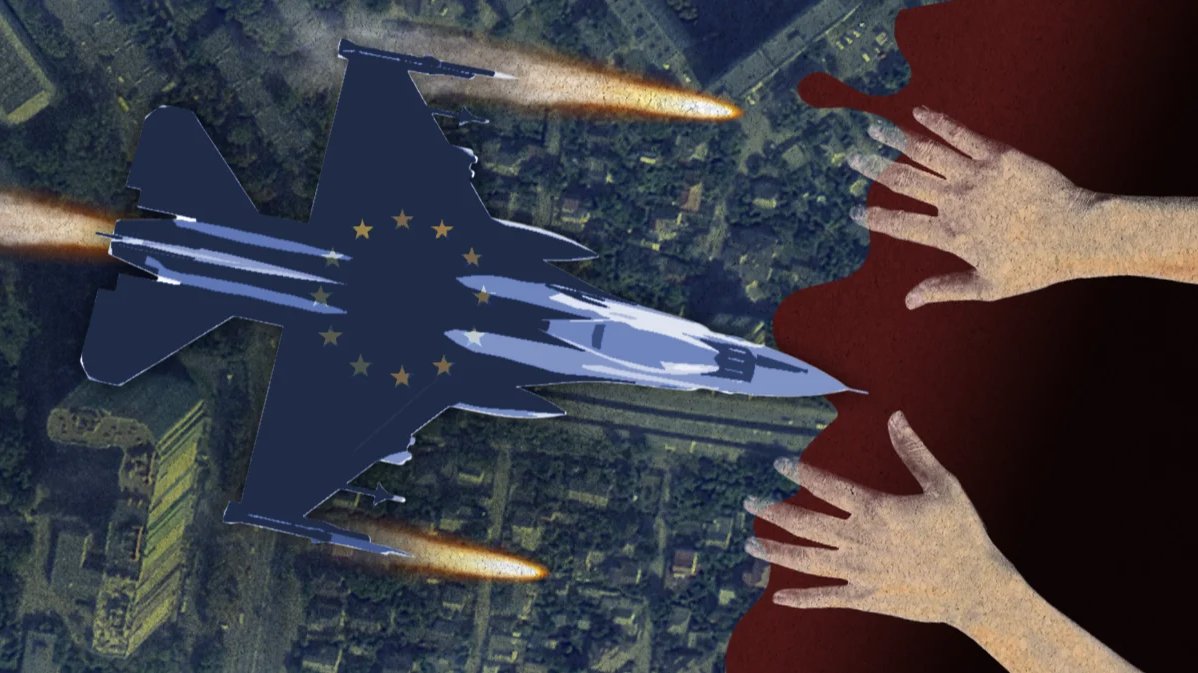“Wings for freedom” — that was the message Ukraine’s President Volodymyr Zelensky used to encourage Western allies to provide his country with modern General Dynamics F-16 Fighting Falcon fighter jets.
This decision was long in the making, but it finally became clear in mid-May that the UK, the Netherlands, Belgium, and Denmark are now ready to share some of their planes with Kyiv. After last Thursday’s “aviation Ramstein”, the US, that was long reluctant to provide the jets, has now confirmed that it would not mind F-16 planes that use US technology to end up in Ukraine.
Although none of the “fighter jets coalition” members are ready to announce the exact dates of the supplies, it is fair to say that training programmes aiming at teaching Ukrainian pilots how to use the Fighting Falcons have been approved. Kyiv is unlikely to receive the fighters before autumn, and the supplies will surely not have any impact on the Ukrainian counteroffensive. However, this decision is a glimpse into the future. The agreement brings Ukraine closer to NATO and acts as a signal to Vladimir Putin that neither Ukraine nor its allies are going to yield in a war of attrition.
Novaya-Europe’s Ira Purysova studies how the “fighters coalition” was formed, why it is led by the Netherlands and Denmark rather than Germany and the US, and whether there will still be any “red lines” in the relationship between Moscow and the West.
A glimpse into the future
The supplies of Western weapons to Ukraine have been relying upon the situation on the front line from the very start of the war. In the first days of Russia’s invasion, when Ukraine needed to take down Russian jets and stop Russian tanks heading for Kyiv, NATO countries provided it with Stinger missile launchers and Javelin anti-tank systems. Last summer, when Ukraine needed to weaken Russia’s defence and disrupt Russian logistics and supplies ahead of its major counteroffensive, Kyiv was provided with long-range artillery. After the Russian military started its mass strikes against the Ukrainian critical infrastructure last autumn and winter, Kyiv received air defence systems. As of May, the sky over Ukraine has become much safer: the Ukrainian military is now able to repel most of Russia’s attacks using Patriot, NASAMS, and other systems, although Russian strikes have become less intense, probably due to ammunition shortage.
However, the matter of F-16 supplies and training for Ukrainian pilots does not seem to fit into this pattern at first sight. The experts Novaya-Europe has spoken to are of the opinion that the fighters will not be able to improve the situation on the front line right away: the counteroffensive may start any day now, and the training alone is going to take four to six months. These days, the announcement of the upcoming supplies for Kyiv looks more like a political move: it is at large a glimpse into the future, the time when Ukraine will have won the war or at least liberated most of the occupied territories.
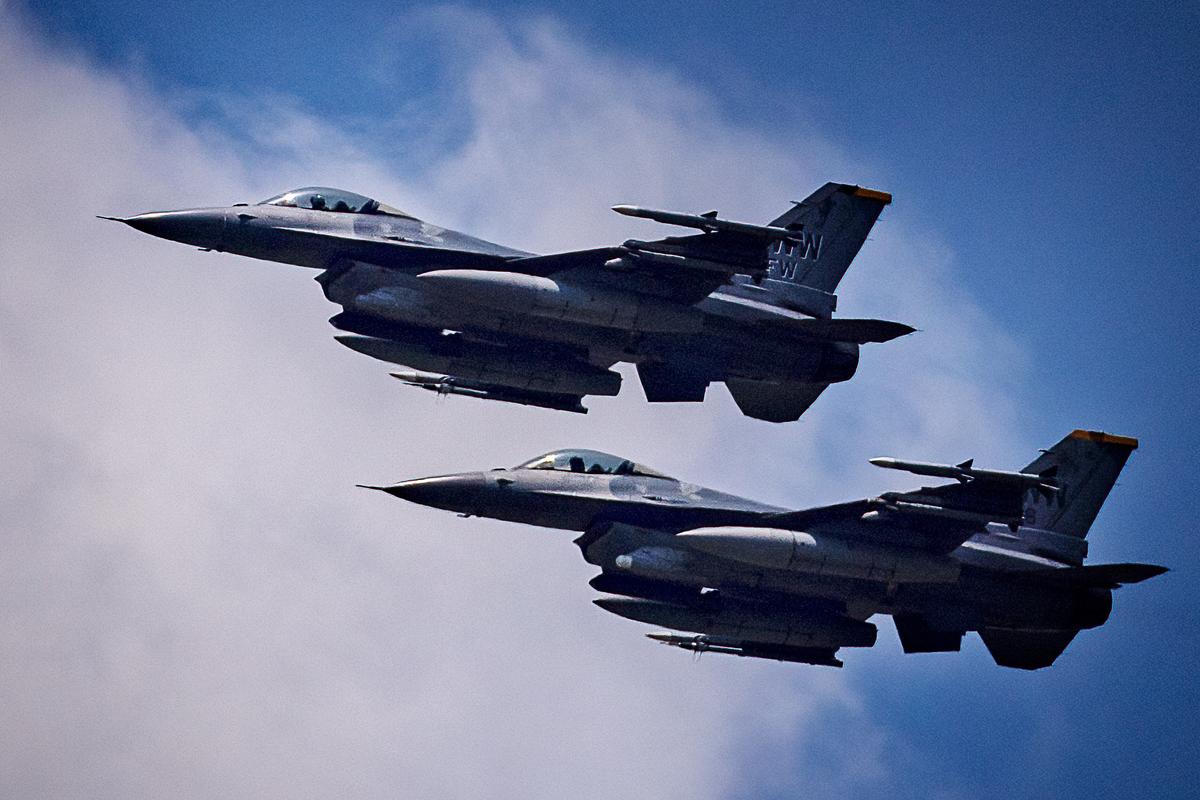
F-16 USAF fighter jets. Photo: Ezra Acayan / Getty Images
Jamie Shea, a professor at the Exeter University and the former Assistant to the Secretary General of NATO, says the talks about the “fighters coalition” are related to the expected success of the Ukrainian counteroffensive. After the offensive, Ukraine will need to improve control over its airspace, which is vital for achieving ground combat success in modern warfare as aviation provides cover for ground-based forces. When the “hot phase” of the conflict is over, the fighters will fit into the system of Ukrainian airspace security.
“I don’t think you’ll see many F-16s this year [in Ukraine], but it’s more of a long-term investment in the air force of Ukraine for after the conflict and for future deterrence,” Shea notes.
The other reason, he believes, is the security guarantees that the Western countries pledged to provide Ukraine with. Despite the fact that its NATO membership bid received no response so far, the member states are willing to offer Ukraine a renewed relationship format to demonstrate political support of its ascension. To achieve rapprochement with NATO, Kyiv will need to continue developing democracy institutions, fight corruption, and switch to NATO military standards instead of Soviet ones, as well as to expand tech cooperation with the alliance. In simpler terms, Ukraine’s military has to become a modern one and be armed with Western equipment. The training will teach Ukrainians how to use this equipment and provide for a sooner ascension.
In addition, the discussion of fighter jet supplies is a signal to Russian president Vladimir Putin that the West no longer has bounds when it comes to supporting Ukraine. It was in March when Secretary General of NATO Jens Stoltenberg said the alliance members will need to prepare for providing aid to Kyiv for a long time since “Putin fights a war of attrition”. The fierce battles around Bakhmut, which lasted almost a year and led to the complete destruction of the city, demonstrate that Russia is ready “to just throw in thousands and thousands more troops, to take many casualties for minimal gains.”
“[The readiness to supply F-16s] sends a signal to Putin that the West is willing to go further, that there are no limits on our support of Ukraine. I think it sends an important political deterrence message,” Shea believes. “Besides, there’s been a lot of talk recently about bilateral security guarantees for Ukraine. Those security guarantees will mean NATO interoperability, a NATO-style modern army with Western equipment.”
‘Wings for Freedom’
“My opinion is that the word ‘if’ is no longer that relevant in this whole fighter supply talk. Nobody would train so many pilots for no reason,” says Leonid Nersisyan, a military analyst and a researcher with the APRI Armenia think tank. “Judging by the latest statements, the fundamental decision has been made already.”
Western fighters are one of the few weapons the allies have not yet provided Ukraine with, despite numerous requests made by Kyiv. Volodymyr Zelensky started to actively ask international allies for aviation supplies in late January 2023, and during his visit to London in February, he suggested a new slogan for the joint UK—Ukraine effort to fight Russia’s aggression: “Wings for Freedom”.
During his trips, Zelensky also started mentioning the training that would enable Ukrainian pilots to use Western aircraft. After his meeting with British PM Rishi Sunak on 15 May, the UK Government announced that a respective training programme would be scheduled for this summer.
At the same time, the UK will be discussing the possibility of providing F-16 jets to Kyiv with other countries.
London’s decision was soon backed by French President Emmanuel Macron and Dutch PM Mark Rutte. More countries joined them later, namely Denmark, Belgium, Portugal, and the US. The allies have started to mention a “coalition” that would aim at purchasing fighter jets for Ukraine, led by the Netherlands and Denmark. However, it only comes down to pilot training so far. Foreign Policy says a total of 20 Ukrainians will start the programme soon.
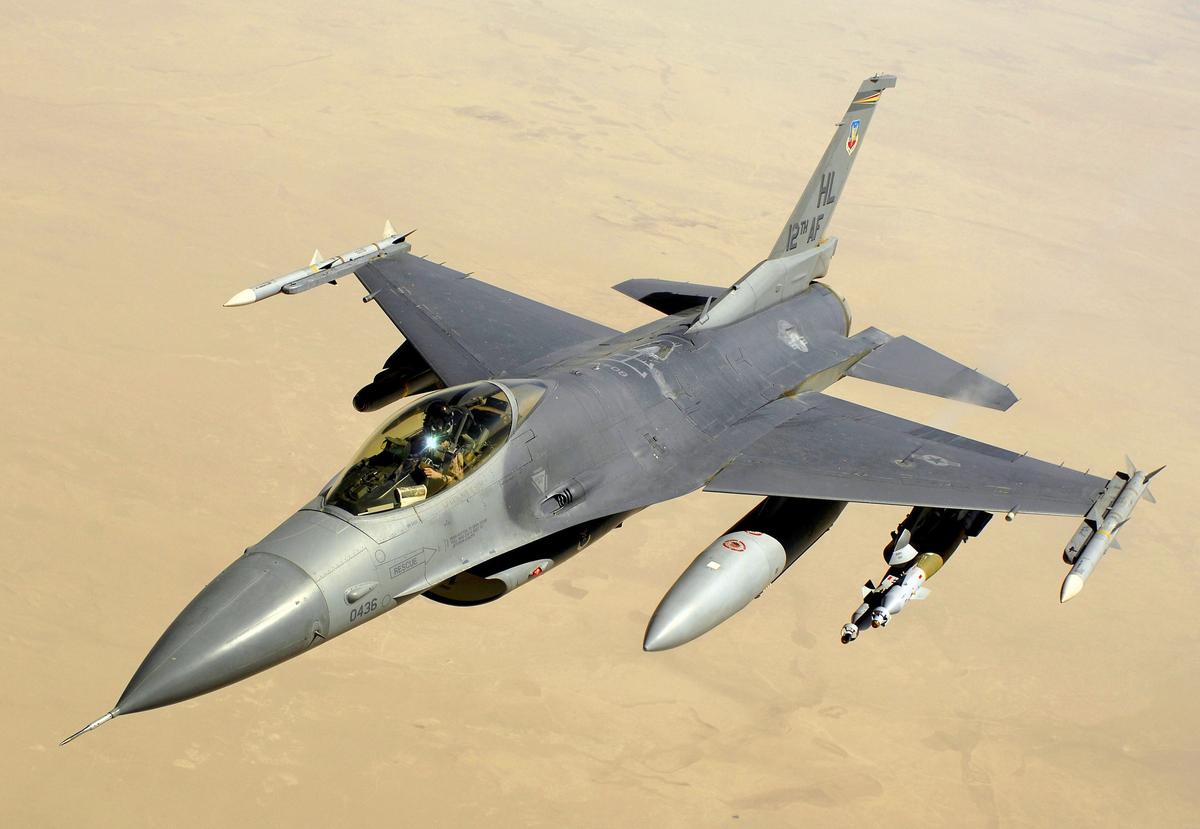
An F-16 Fighting Falcon jet. Photo: Wikimedia
It remains unknown when Ukraine is to expect the jets: none of the countries in the coalition are ready to announce the supply date publicly. The Netherlands, Denmark, and Belgium have agreed to train the pilots, however, Politico says these countries are wary of promising anything more than that. Belgium even stated that it has no extra jets.
Ukrainian media outlets were hoping for the situation to become clearer on 25 May when the Ukraine Defence Contact Group met at the US Ramstein military base in Germany. The group unites 50 countries that support Kyiv in its fight against Russia, including states outside NATO or the EU, such as Japan, South Korea, and New Zealand. The first Ramstein meeting happened in April 2022, and the latest event was the twelfth one.
Despite the May Ramstein meeting being called the “aviation one”, little changed after it finished: the countries only confirmed the intentions they had announced previously. During the meeting, US Secretary of Defence Lloyd Austin evaded the question when he was asked how many F-16 jets the US can provide, stating that the allies are currently more focused on supplying air defence systems.
“We wanted to focus and have been focusing [on the fact that] Ukraine needs to defend itself, protect its infrastructure, and protect its people. And the capabilities that we’ve managed to put together as a result of what we’ve provided and also what our allies and partners have provided, as you can see, are very impressive. They continue to grow. It’s not enough. We’ll continue to work on it and we’ll continue to work to create a follow-on force capability for the Ukrainians as well,” Austin said.
This situation was pretty much like the January “tank Ramstein” when member countries were waiting for Germany’s approval to re-export Leopard tanks. Germany refused to grant the approval (it only greenlit it a few days after), and there were no ultimate announcements at the meeting. However, a repeat of this situation is unlikely: the US, which owns the licence for the Fighting Falcons, approved the jets supply quite fast, and even referred to this as a priority objective.
“President Biden has made it very clear that we will begin training the Ukrainian military in F-16 piloting and will work with our allies and partners to provide Ukraine with F-16 jets,” US State Department official Matthew Miller stated on 22 May.
‘Fighting falcons’ in warfare
The Ukrainian Air Force currently has Soviet MiG-29 and Su-27 fighters at its disposal. Same as with other types of weapons, providing Ukraine with equivalent aircraft is no problem for Western countries. Slovakia and Poland agreed to supply MiG-29 jets to Ukraine in early May. But these planes and F-16s are “worlds apart” in terms of capabilities, military analyst Leonid Nersisyan says. Serhiy Holubtsov, Ukrainian Air Force commander, says the American aircraft are “four or five times” more advantageous. Holubtsov believes that the Soviet jets are “better than nothing” but not enough to fully repel the Russian Air Force, while the modern American fighters are capable of fulfilling all sorts of combat missions.
Despite having a longer combat range and higher manoeuvrability in close combat, the MiG-29 jet is considered obsolete. Unlike the F-16, its tech saw no upgrade since the early 1980s. The modern “Falcons” are equipped with a better radar that allows its pilots to detect three times more targets; they have a larger ammunition load (511 shells vs. the 150 shells MiG-29 has), and are less prone to detection by air defence systems. Additionally, the American fighter is versatile: apart from being a close combat machine, it can also be used as a scout, a bomber, or as a strike-fighter.
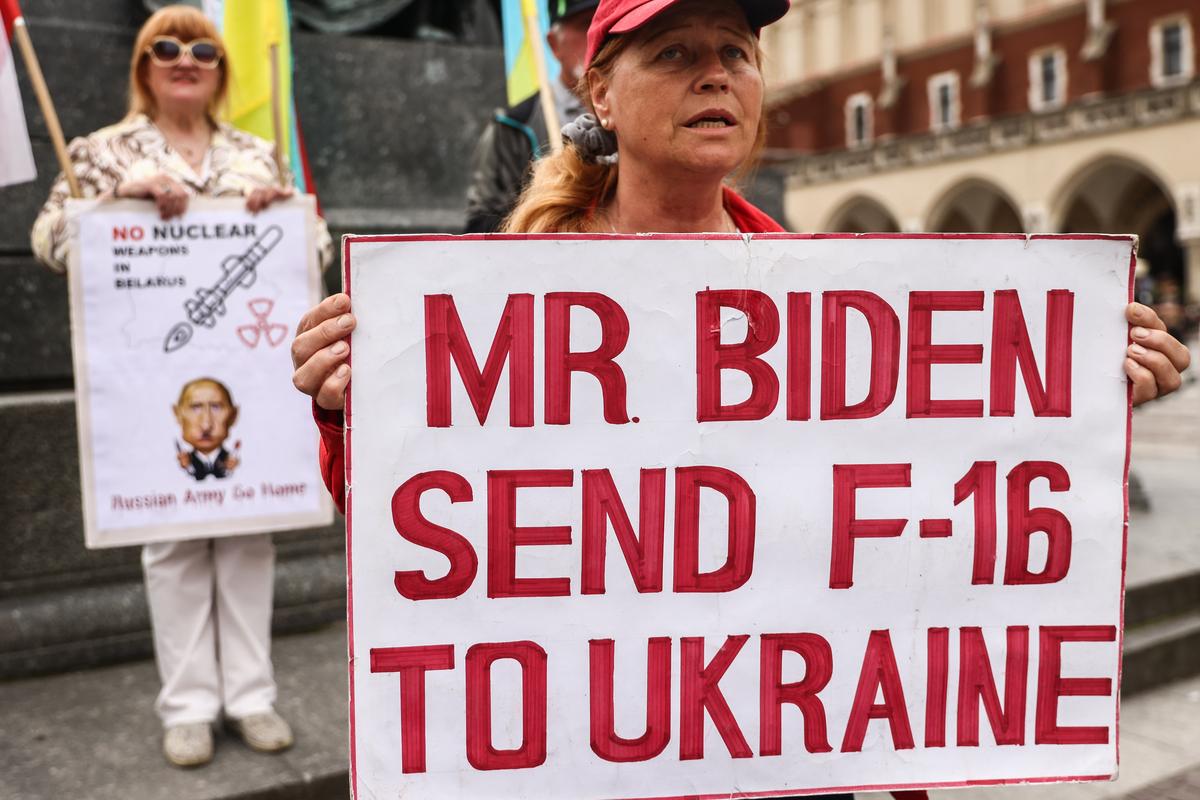
A woman holding a poster demanding to provide Ukraine with F-16 fighters, Kraków, Poland, 16 May 2023. Photo: Beata Zawrzel / NurPhoto / Getty Images
“MiG-29 and F-16 are in the same class of light fighters. The American one is obviously more advanced in terms of electronics,” Nersisyan says. “The F-16 can use guided weapons to attack both ground-based and airborne targets. Besides, when it comes to comparing jets, many people forget what kind of ammunition those may use that militaries have at disposal. Unlike Russia, the West has been producing large amounts of ammunition for its modern fighters for years. This increases the aircraft’s capabilities.”
Military experts believe the number of F-16s and the amount of ammunition produced by the West influenced the decision to provide those to Kyiv, among other things. As per Flight International, there are almost 2,200 active fighters of this type worldwide as of 2023, and 1,500 of those are at disposal of NATO members.
The American F-16 fighter was the most widespread 4th generation combat plane between 1975 and 2010. During this period, around 4,600 such fighters were manufactured. Currently, NATO countries use over 1,500 F-16 jets.
- US: 1,017;
- Turkey: 270;
- Greece: 154;
- Norway: 57;
- Belgium: 53;
- Poland: 48;
- Denmark: 43;
- The Netherlands: 42;
- Portugal: 28;
- Romania: 17.
Choosing a mass production model would allow Ukraine to have more pilots with relevant flying experience. Since modifications of the same model may differ greatly, pilots need to learn how to fly each of those models separately. Training takes a lot of time. It is better to teach the pilots to fly exactly the planes that are most likely to be provided to Ukraine. Additionally, the F-16 requires simpler maintenance than the European Tornado aircraft or the newer US F-35 fighter. All these factors are expected to make integration of Western fighters into the Ukrainian Air Force easier.
Nersisyan believes that theoretically the fighter supply should not cause as much trouble as it was with the Leopard 2 tanks.
This can be explained by trends: during the past two decades, the West has been focusing on manufacturing aircraft, so the Western aviation has higher combat readiness than other types of equipment.
The expert believes that the aviation capacity of donor countries will not suffer a major decrease even in case Ukraine receives 400 F-16 fighters. He says the first Western jets may arrive in Ukraine no later than three or four months.
The price of supplies
However, there are drawbacks that may put the provision of F-16s off indefinitely. The first one is the price of fighters. Unlike tanks and other military equipment, the price is particularly high. Even though the F-16 is not the most expensive fighter, each jet is valued at over $30 million. For comparison, one Leopard 2A6 tank costs about $8 million, and this is its more expensive modification, while Leopard 2A4s worth up to $3 million were also provided to Ukraine. Jamie Shea notes that even several fighters may carve a hole in the military budget of a donor country. The ammunition for F-16 is also rather expensive: one AIM-120 missile compatible with such fighters is valued at over $1 million.
Another issue is the capabilities of countries to provide the planes. Shea looks at this from a more sceptical perspective than Nersisyan does. He says that some of the European jets are deployed for other purposes: for instance, F-16s are used in patrolling the airspace of the Baltic states, a mission called the Baltic Air Policing. Additionally, the US has already pledged to provide Turkey with $259 million worth of F-16 fighters. The country will receive those in exchange for approving Finland as the new NATO member. Taiwan also made a major order of F-16 from the US in 2019; this contract is expected to be fulfilled by 2026.
Shea believes that the Americans may have to ask the F-16 manufacturer Lockheed Martin Corporation to increase the production of F-16s so that those can later be transferred to Ukraine. Frank A. St. John, chief operating officer for Lockheed Martin Corporation, mentioned in January 2023 that such a scenario was possible, noting that the company was not a party to any negotiation. However, the supply of new fighters will take three to six years.
One more issue is maintenance. According to the ex-NATO official, the service life of the F-16 fighter is only 8,000 flight hours, but in order for the planes to fly, hundreds of trained personnel are needed to repair them, set up electronics, and prepare weapons systems. All of this costs money.
“Imagine that every time you use your car, you have to take it to the garage for a service. It would be financially crippling for you,” Shea explains.
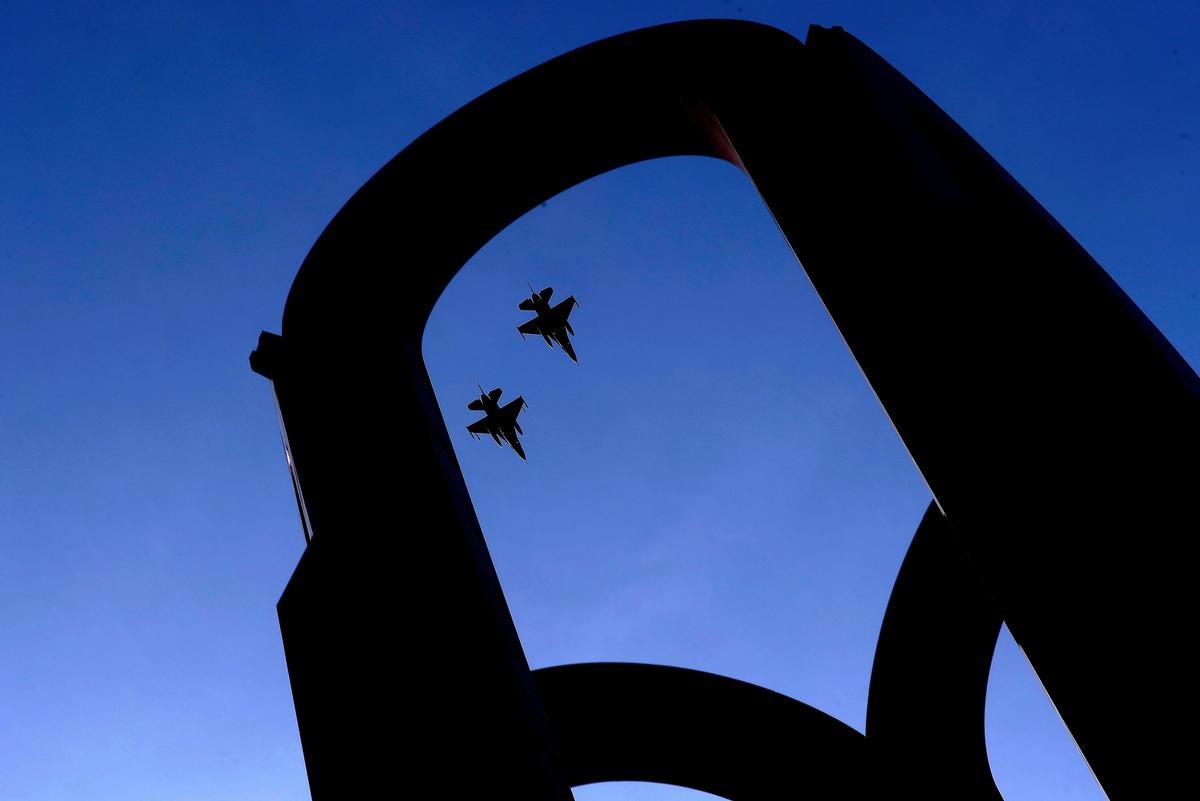
Photo: EPA-EFE / ROBERT GHEMENT
In addition, in order to operate modern fighters, the same modern airfields are needed. Many countries doubt that Ukraine will be able to provide the necessary infrastructure. NATO cannot provide trained personnel to maintain the jets on Ukrainian territory either as that would mean the Alliance’s direct involvement in the war. The parties will need to decide during the pilots’ training course whether the jets will be maintained in Ukraine or in a neighbouring country.
However, despite all this, four EU countries and Norway have privately indicated that they are ready to provide aircraft to Ukraine, a source of The New York Times says. According to the British International Institute for Strategic Studies (IISS), Belgium, the UK, Denmark, and the Netherlands may supply at least 125 F-16 fighters in full combat readiness.
Among other things, this is influenced by the fact that many countries were planning to decommission their F-16s in exchange for more advanced F-35s.
So far, the Netherlands and Denmark have demonstrated the greatest willingness to transfer the fighters, and there is a good reason behind their leadership in the coalition. Danish Defence Minister Troels Lund Poulsen said in late February that the country was “open” to the idea of sending F-16 fighter jets to Ukraine; the Danish military has 30 such aircraft, although last week Poulsen said that only the training of pilots had been discussed so far, and that talks about the actual supplies of aircraft are about start around September. This is when F-16s will be replaced by newer models.
The Netherlands may also become a donor country: according to a representative of the Dutch Defence Ministry, there are 18 F-16 fighters in the reserves of the Dutch military: “those are no longer used in combat operations” and “can also be transferred to another destination.” Initially, 12 of them were supposed to be provided to Draken International, a private company, but the deal has been postponed. Dutch PM Mark Rutte says the Netherlands are considering the possibility of transferring the fighters. Bloomberg sources say that the transfer of fighters to Ukraine may happen in mid-2024 after the training of the first pilots is completed.
Division of labour
Germany is one of the European countries that has not yet joined the “coalition of fighters”. In mid-May, when talks of building a “coalition” just started, German Chancellor Olaf Scholz announced that the country would focus on tanks, ammunition and air defence supplies.
The statement was made after Germany had announced that it was preparing its largest package of military assistance to Ukraine worth almost €2.7 billion: this was one of the results of Volodymyr Zelensky’s trip to Germany. The new package will include Marder IFVs, Leopard 1 tanks, Gepard self-propelled anti-aircraft guns, IRIS-T SLM air defence systems with ammunition, and other types of heavy weaponry. It was revealed on the eve of the twelfth Ramstein meeting that the country’s government was ready to go: Ukraine’s ambassador to Germany Oleksiy Makeiev announced the supply of 110 Leopard 1A5 battle tanks. All this is strikingly different from Germany’s cautious behaviour during the formation of the “tank coalition”.
According to Alexey Yusupov, head of the Russian programme at the Friedrich Ebert Foundation, Germany’s record deliveries show that the country continues its policy of supporting Ukraine that was chosen last winter. In addition, Germany’s newly appointed Defence Minister Boris Pistorius initiated a check of the Bundeswehr stocks soon after taking the position. The check lasted several months. That is why the new aid package includes the supply of Leopard 1 tanks, Yusupov says. These tanks are not as relevant as the Leopard 2 ones, but those were recently inspected and prepared and the necessary parts were collected so that the tanks could be used on the battlefield.
Germany’s decision to greenlight the supply of battle tanks removed a block on the transfer of major military equipment to Ukraine in German society.
Prior to that, it was hard for Germans to imagine that their country might take military assistance to Ukraine to a new level. Polls showed that about a half of Germans were against the supply of Leopards, in particular because they feared that this would be a turning point for the country, after which Russia would begin to consider Germany a party to the conflict. In addition, the collective WW2 trauma affected the German nation: a proportion of the country’s population could not accept that German tanks would again go eastward and fight in Ukraine. A lot has changed since then, though.
“After the decision on tanks had been made, it became clear that there was no turning point. Those who used to be against the supplies now have a less firm stance. Although there are still sceptics, the mental barrier has been passed,” Yusupov says. “The latest German package for Ukraine’s military is not new in quality terms, but is new in terms of quantity and budget. It showed that the approval of the Leopard supplies was about ultimately choosing the policy on Ukraine. Germany will follow this policy this year, and next year as well. It will follow this policy as long as the war continues.”
Germany’s full participation in the “coalition of fighters” is impossible simply because the country does not have its own F-16 fighters Ukraine needs. The German military is armed with other European models. The country is far from being a leading power in the production of aircraft, so there are no expectations from other allies, and there is no pressure on Germany. Even if the country decides to participate in the “fighters coalition”, its assistance will still be either financing, or training pilots, or providing auxiliary weapons. Ingo Gerhartz, the commander of the German Air Force, assumed that it might be possible.
The main question is whether Germany will supply Ukraine with Swedish-German Taurus cruise missiles, which can be adapted for F-16 fighters. Ukraine requested those a few days ago. Taurus is designed to engage ground targets at a great distance without the carrier aircraft entering the enemy’s air defence coverage area. This missile has a range of up to 500 km.
Yusupov’s conclusion is that Germany’s desire not to participate in the coalition shows that there is more and more talk about the “division of labour” in Europe in terms of military assistance to Ukraine. Specialisations of different countries are shaping up. Germany is in charge of repairs, artillery, tanks, and air defence systems (apart from the US Patriot, Ukraine also uses German IRIS-T systems). At the same time, other countries will be in charge of offensive aviation, and Germany will not be in their way.
“The distribution of tasks between the countries of the alliance is, in fact, correct, because there has been no special coordination since the beginning of the war. You could say that everyone was providing their reserves, getting rid of the equipment that was unused or received under the Warsaw Pact,” the political scientist says. “This phase is now over, so I do not really expect changes in Germany’s stance on this issue. It is more likely that there will be a request [from Ukraine] to receive specific German-developed weapons.”
Support independent journalism
No more ‘red lines’
The “fighters coalition” in its current form shows two things, Shea says. “Number one, you won’t see many F-16s in the immediate future. But the pilot training creates a political momentum where it’s no longer taboo, and that will apply pressure to deliver the planes. Secondly, the number is likely to be fairly limited for some time to come. So the question is, if you give Ukraine six F-16s, does it make a difference in terms of their capability? Quality is great, but you need numbers as well.”
However, the Ukrainian Defence Ministry tweeted on 26 May that it needs four squadrons of F-16s, or 48 aircraft in total, to liberate its territory from the Russian invasion. Nersisyan agrees upon that figure. The military analyst points out that aviation plays a limited role in this war.
Russia cannot use aviation, since the air defence system of Ukraine was not destroyed in the first days of the war, and now Russian aircraft are cut off from the Ukrainian sky. Attempts to use aircraft lead to huge losses of combat aviation. In addition, Russia does not have modern guided aircraft weapons, and its pilots have no combat experience in conducting such operations.
Ukraine cannot actively use aviation either. Nersisyan notes that the Ukrainian Air Force does not have many aircraft, and the ones it has are obsolete. Those also cannot be used over Russia proper or Ukrainian occupied territories, since those are likely to be shot down either by Russian air defence systems or by fighters. The aircraft can be used both to support the military on the front line and to strike with long-range Storm Shadow cruise missiles, which the UK recently provided Ukraine with. Ukraine will not be allowed to strike the territory of Russia proper with F-16s as it is one of the deal’s conditions.
Although there is still no decision on supplies, the Kremlin has already responded to the actions of Europe and the US: Dmitry Peskov, Vladimir Putin’s spokesman, referred to the potential supplies as to a continuation of the “step by step” escalation, but added that the aircraft would not fundamentally change the situation. According to experts interviewed by Novaya-Europe, despite the fact that the threat of a tactical nuclear strike remains relevant, its probability is not so great, as time has shown. Leonid Nersisyan even says that in fact there are no “red lines”.
Attacks on Russian territory prove that, although Kyiv has never formally admitted its connection to any of those. A few weeks ago, drones attacked the Kremlin. On 22 May, according to local authorities, a “sabotage and reconnaissance group of the Armed Forces of Ukraine” entered the territory of the Grayvoronsky district of Russia’s Belgorod region (those were fighters from the Russian Volunteer Corps and the Freedom of Russia Legion, sided with Ukraine). An office building and a residential building were damaged in Russia’s Krasnodar on 26 May as two drones fell. On 27 May, several facilities were attacked in the Pskov region.
“Strikes on Russian territory are being executed every now and then. As this causes no radical reaction from the Kremlin, it is clear that the ‘red line’ becomes more and more blurred,” Leonid Nersisyan says.
Join us in rebuilding Novaya Gazeta Europe
The Russian government has banned independent media. We were forced to leave our country in order to keep doing our job, telling our readers about what is going on Russia, Ukraine and Europe.
We will continue fighting against warfare and dictatorship. We believe that freedom of speech is the most efficient antidote against tyranny. Support us financially to help us fight for peace and freedom.
By clicking the Support button, you agree to the processing of your personal data.
To cancel a regular donation, please write to [email protected]
